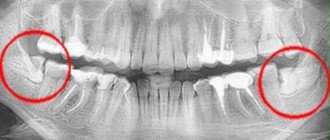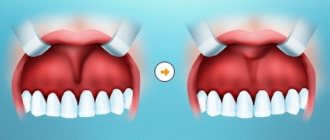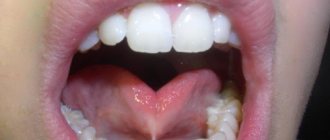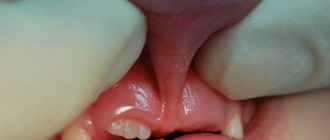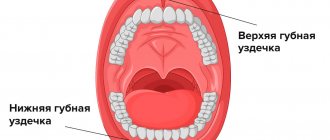But if surgical plastic surgery of the frenulum is still performed, then in our clinic it is only laser surgery.
This method has a number of advantages:
- smaller volume of anesthetic;
- the manipulation lasts only 10 – 15 minutes;
- the edges of the wound are instantly “sealed” (due to gluing the end sections of the vessels under the influence of the laser), which prevents bleeding;
- no need for stitches;
- 100% sterility of the surgical field, which eliminates the risk of complications;
- faster healing, facilitating the postoperative period.
What is lingual frenuloplasty?
The frenulum is a small membrane that connects the lower part of the tongue and the mucous membrane of the lower jaw. Despite its small size, it performs very important functions: it is responsible for the formation of dental occlusion, controls the mobility of the tongue and the functioning of the facial muscles.
There are three main pathologies of the tongue frenulum that require surgical correction.
- Wrong shape.
A healthy frenulum is a fold of mucous membrane in the shape of an arc. - Small size
(in medical terminology - ankyloglossia). The average length of the frenulum of the tongue in an adult is 3 centimeters; in a child it is shorter. In the case of ankyloglossia, the frenulum will not allow the tongue to be raised completely upward. - Incorrect mounting location.
A healthy frenulum is attached to the middle of the tongue, and with pathology it can be shifted to the tip.
In some cases, it becomes necessary to perform plastic surgery of the lip frenulum - the fold of mucous membrane connecting the lip and gum. The operation is performed to avoid impaired diction and the formation of malocclusion. Read more about lip frenuloplasty here.
Short frenulum and why it is dangerous
Shortening of the frenulum is understood as a decrease in its absolute length or its incorrect location, which makes it relatively short (i.e., the length remains normal, but its incorrect localization causes all the symptoms characteristic of shortening).
A short frenulum of the upper or lower lip in a baby can negatively affect the process of breastfeeding. In this case, the child cannot correctly position the nipple in the oral cavity and create a sufficient vacuum necessary for sucking and swallowing. Therefore, in order to get enough, the baby has to make significant efforts. The baby quickly gets tired and stops breastfeeding without being properly satisfied. Such children behave restlessly, require frequent breastfeeding, but do not gain weight well.
In children over 3 years old, a shortened upper frenulum can cause an increase in the interdental spaces between the upper incisors and their advancement sharply anteriorly. A short lower labial frenulum sometimes causes malocclusion.
Also, a decrease in size or incorrect location of any of them can have an extremely negative impact on speech function. Children 2 years of age who have not had this pathology diagnosed or corrected in time often do not pronounce individual sounds. Such speech defects are difficult to correct.
Causes of tongue frenulum anomaly
Most children have mild pathology, but severe forms are also not uncommon. The size of a child’s tongue frenulum is most often determined by heredity, as well as the following factors:
- viral infection in the mother in the first and last trimesters;
- late toxicosis;
- exacerbation of chronic diseases during pregnancy;
- injuries in the abdominal area during gestation;
- taking potent drugs by the expectant mother.
Symptoms of a shortened frenulum
How to determine if your baby needs surgery? It is necessary to seek specialist advice. However, you can notice signs of a defect in the frenulum of the tongue yourself by paying attention to some details.
- The frenulum resembles a transparent film and does not have a vascular network.
- The tongue is inactive.
- The child cannot reach the upper palate with the tip of his tongue.
- When you move your tongue, clicks are heard.
- Chewing and swallowing are difficult.
- Diction is broken.
- The lower front teeth are turned towards the tongue.
When and who needs tongue frenuloplasty?
Most often, an abnormality of the frenulum of the tongue can be diagnosed in a child immediately after birth. Then it is recommended to fix it. However, plastic surgery is performed on children of preschool and school age, as well as adults. The operation is indicated in the following cases.
- Violation of sucking in newborns.
If babies have a tongue frenulum that is too short, they cannot latch onto the nipple properly, resulting in underweight, fussiness, and poor sleep. - Diction defects.
Due to poor tongue mobility, children distort some sounds, especially “r”, “l” and hissing sounds. As a rule, the problem is discovered by a speech therapist in preschool age. - Abnormal shape of teeth and gums.
A tongue frenulum that is too short can interfere with proper growth of the lower jaw. This leads to incorrect positioning of the front teeth and gum recession. - Preparation for implantation and prosthetics.
Any deviations in the shape of the soft tissue from the norm can ultimately lead to implant failure, so they need to be corrected before surgery. The discomfort caused by the pathology of the frenulum of the tongue during the use of removable dentures, especially on the lower jaw, is also important: the structures simply fall out when talking or eating.
Advantages of laser surgery at the Novostom clinic
- Individual approach. The specialists of the Novostom clinic are ready to take into account all your requests and wishes. They will assess the condition. If necessary, other specialists (speech therapist, orthodontist, etc.) will also join the examination.
- Prompt delivery, there are no queues. We don't make patients wait long. You can make an appointment at a time convenient for you.
- Comfort. During any interventions and preparation for them, patients are surrounded by the attention of the staff. We care about the emotional state of our clients. A pleasant pastime is guaranteed for everyone. You can familiarize yourself with the presented press, spend time with a cup of coffee, and use the Internet access. Even a child will not be capricious if you bring him to us.
- Safety. Treatment of periodontitis is carried out under sterile conditions in compliance with all sanitary and hygienic standards.
- Professionalism of specialists. To eliminate all problems, doctors use modern developments and techniques. They rely on both their existing knowledge and accumulated experience. This avoids any mistakes. By contacting us, you can be sure that all actions of specialists will be competent and accurate.
- Availability of necessary equipment. We have all the equipment and tools to carry out the proposed interventions. Our specialists use only high-quality consumables. Do you want to fix a deficiency? Are you planning to bring your child to the Novostom clinic? Contact us!
What happens if tongue frenuloplasty is not performed in children?
An abnormality of the frenulum of the tongue in children provokes the following serious consequences.
- Due to a violation of the sucking regime in infancy, the child may not receive enough nutrition and, as a result, lag behind in development.
- Children with tongue frenulum abnormalities may never learn to pronounce some sounds.
- Incorrect placement of the frenulum leads to underdevelopment of the lower jaw, resulting in the formation of an incorrect bite.
If pathology of the frenulum of the tongue has been identified in a newborn, it can be easily corrected by making an incision with a laser. At this age, you won't even need stitches. With age, the structure of the frenulum becomes more complex, new vessels appear in it, so plastic surgery of the frenulum in preschool and school-age children turns into a full-fledged surgical operation. Therefore, it is best to do it at the age of 5-6 years, when the child’s milk teeth are replaced by permanent ones.
Parents can determine whether their child needs surgery on their own. To do this, ask him to reach the upper palate with the tip of his tongue. If he cannot do this, or it hurts, he should consult a doctor.
Surgical correction
If a short frenulum is detected in the maternity hospital, then its trimming is carried out immediately. This is done so that the baby can properly take the nipple and eat properly. If shortening is diagnosed at an older age and is not corrected by speech therapy techniques, then three options for surgical treatment are possible:
- Frenotomy is cutting to increase its length.
- Frenectomy is a circumcision when it is almost completely excised.
- Frenuloplasty is a plastic surgery during which the place of its attachment in the mouth is changed.
Despite the fact that frenulum surgery itself is quite common, most parents have a lot of questions about this procedure. We will consider the main ones below.
Why trim?
A too small size of such a fold of the mucous membrane can cause difficulty sucking at the breast in infants, and problems with the pronunciation of certain sounds and with the arrangement of teeth in the permanent dentition in older children. To avoid such problems, pruning is required.
Do I need to prune?
Most doctors, including the famous Dr. Komarovsky, are of the opinion that a short frenulum should be trimmed if it adversely affects the child’s ability to suck milk or pronounce certain sounds.
When a short frenulum does not negatively affect the processes of sound production and bite formation, then in such cases surgical intervention is not required.
What kind of doctor cuts?
Typically, frenulum correction operations are the responsibility of a dentist.
At what age is it best to have surgery?
When the frenulum should be trimmed is decided individually for each child. If we are talking about a fold on the upper lip, then correction is done no earlier than 6 years. Typically, the operation is performed only after the eruption of the permanent upper incisors. If correction is required on the lower lip, this is done more often after the 4th year of life.
In most cases, the hyoid frenulum is cut before 1 year of age (most often this is done in the maternity hospital). But correction is possible at any age.
How do they prune?
The frenulum trimming operation is performed on an outpatient basis in the surgical office of a dental clinic. The doctor carefully stretches the fold of the mucous membrane and makes a small incision with a sharp scalpel. After that, small sutures made of threads are applied to the edges, which after some time dissolve on their own and do not need to be removed.
A more modern technique is laser dissection, which eliminates the need for stitches, which speeds up the child’s recovery process.
Does it hurt to prune?
The dissection procedure is performed under local anesthesia, which eliminates the possibility of any pain.
«
Operation techniques
There are two methods of performing tongue frenuloplasty: traditional (classical) and laser. This is a more modern and safer method. The laser allows the operation to be performed with great precision and does not cause bleeding after the procedure. In addition, there is no need for stitches, and healing time is significantly reduced. This is especially important if you need to perform laser frenuloplasty on a child: the baby will tolerate the procedure much easier.
Depending on what pathology of the frenulum is detected, the doctor uses one of three techniques: cuts the frenulum, removes it, or changes the attachment site. The number of cuts and their shape depend on the choice of technique.
Therapeutic exercises
There are alternative methods that allow you to do without surgery, for example, a set of special exercises for developing the frenulum of the tongue.
- Reach alternately to the upper and lower lips.
- Extend your tongue and make pendulum movements from cheek to cheek.
- Suck your tongue to the roof of your mouth and let go, imitating a horse clopping its hooves.
- Place your tongue on each cheek with your mouth closed.
- Smile with your mouth open.
- Stretch your lips.
- Pull your lips into a tube, pretending to kiss.
To achieve results, you need to perform the exercises every day for 5 - 10 minutes. It is important to remember that this method is suitable for correcting mild disorders; more severe pathologies require surgical intervention.
Consultation with a speech therapist “How to stretch the hyoid frenulum?”
Natalia Khryakova
Consultation with a speech therapist “How to stretch the hyoid frenulum?”
The hyoid frenulum is a membrane that connects the tissues of the floor of the mouth and the tongue.
A short hyoid frenulum is located too close to the tip of the tongue and limits upward movement of the tongue.
Description and rules for performing exercises for the hyoid frenulum .
Exercises to stretch the hyoid frenulum are performed as often as possible, up to 5-7 times a day for 10-15 minutes. Be sure to check that the exercises are performed correctly in front of a mirror.
According to the recommendations, the basic rules for conducting articulation exercises include:
• slowness, lack of haste and maximum impact;
• good mood, smile and wide open mouth;
• it is necessary to alternate between exercise and rest, because such activities are serious physical activity.
Attention! If the child has undergone surgery to trim the hyoid ligament , then the given exercises must be performed for stretching and development, since it happens that the frenulum grows together and the situation becomes worse than it was before the operation. The child also needs to be seen by an orthodontist or dentist. It must be remembered that exercises can only be performed under the supervision of a speech therapist .
A set of exercises for stretching the hyoid ligament ( " frenulum "
).
"Chicks"
The mouth is wide open, the tongue lies quietly in the oral cavity.
"Spatula"
The mouth is open, a wide, relaxed tongue rests on the lower lip.
"Needle"
Open your mouth. Stick your tongue far forward, tense it, make it narrow. Hold in this position for up to 15 seconds.
"Tube"
The mouth is open, the lateral edges of the tongue are curved upward.
"Watch"
The mouth is open. Lips are stretched in a smile . The tip of the narrow tongue alternately stretches at the teacher’s count to the corners of the lips.
"Swing"
1. Smile, open your mouth. On the count of "one-two"
alternately rest your tongue on the upper and lower teeth. The lower jaw is motionless.
2. Smile, open your mouth, reach with the tip of your tongue first to your nose, and then to your chin, then again to your nose, and then again to your chin.
"Football"
Close your mouth, press the tip of your tongue with tension into one or the other cheek.
"Delicious jam"
The lips are stretched into a wide smile , so that all the teeth are visible. The lower jaw is lowered, the distance between the teeth is 1-1.5 fingers. The tongue lies quietly in the oral cavity.
Without changing the position of the lips and lower jaw, stick out the wide tongue forward, bend its wide tip upward, covering the upper lip with it. Then we remove the tongue into the oral cavity, as if licking the upper lip from top to bottom. A child can, in fact, smear jam or honey on his upper lip.
Attention! The tongue moves strictly in the up-down direction. The lips and lower jaw should be motionless during the exercise.
"Painter"
The lips are stretched into a wide smile , so that all the teeth are visible. The lower jaw is lowered, the distance between the teeth is 1-1.5 fingers. The wide tip of the tongue rests against the base of the upper incisors, the lateral edges of the tongue are pressed against the base of the molars.
The wide tip of the tongue moves as far as possible into the depths of the mouth, without leaving the upper palate, as if stroking it, and returns back in the same way.
Attention! Make sure that the lower jaw is motionless and does not move forward.
“Brushing the upper teeth”
Smile so that both the upper and lower teeth are visible; Open your mouth wider. The chin is motionless! Use the tip of your tongue to vigorously rub the tubercles behind your upper teeth from side to side from the inside.
"Drum"
The lips are stretched into a wide smile , so that all the teeth are visible. The lower jaw is lowered, the distance between the teeth is 1.5 fingers. The wide tip of the tongue rests on the base of the upper incisors.
We pronounce sounds: “d-d-d”
at a fast and slow pace.
Attention! Only the tip of the tongue works, the lower jaw and lips are motionless.
"Horse"
The lips are stretched in a wide smile , so that all the teeth are visible. The lower jaw is lowered, the distance between the teeth is 1.5 fingers. The wide tip of the tongue rests on the base of the upper incisors. The anterior part of the back of the tongue is tightly pressed to the upper alveoli. The lateral edges of the tongue are pressed against the base of the molars.
We forcefully tear the tongue away from the teeth and palate and lower it down. The exercise can be performed at a fast or slow pace.
Attention! The lower jaw continues to remain motionless.
"Fungus"
The lips are stretched into a wide smile , so that all the teeth are visible. The lower jaw is lowered, the distance between the teeth is 1-1.5 fingers. The wide tip of the tongue rests on the base of the upper incisors. The anterior part of the back of the tongue is tightly pressed to the upper alveoli. The lateral edges of the tongue are pressed against the base of the molars. In the gap between the upper and lower teeth, you can see the body of the tongue, resembling a mushroom cap, and a stretched hyoid ligament , reminiscent of its stem.
We hold this position for as long as possible, ideally up to 10 seconds.
Attention! The lower jaw remains strictly motionless.
"Harmonic"
The lips are stretched into a wide smile , so that all the teeth are visible. The lower jaw is lowered, the distance between the teeth is 1-1.5 fingers. The wide tip of the tongue rests on the base of the upper incisors. The anterior part of the back of the tongue is tightly pressed to the upper alveoli. The lateral edges of the tongue are pressed against the base of the molars.
Now we slowly lower the lower jaw until it is possible to hold the tongue in place, pressed to the palate. Feel how “ frenulum ”
?
Now we just as slowly return the lower jaw to its original position. The exercise is performed first at a slow, then at an increasingly faster pace. The hyoid ligament stretches and contracts like the bellows of an accordion.
Attention! During the exercise, the lower jaw falls straight down, without moving forward or moving to the side.
"Household"
exercises to
stretch the hyoid ligament :
1. Licking plates from shallow to deep.
2. Eat ice cream by licking it with your tongue.
3. Licking jam from a large tablespoon with your tongue (yogurt, honey, condensed milk, etc.)
4. Licking a large Chupa Chups
and so on.
Price for plastic frenulum of the tongue
The cost of this procedure usually consists of the cost of consultation and examination, local anesthesia and the service itself. This is a fairly simple surgical procedure, so no additional tests are required. The price of a classic operation (with a scalpel) for adults and children is the same, but may be slightly higher if the patient has too dense frenulum tissue. Then they do not give local anesthesia, but general anesthesia; it costs more, and, accordingly, costs increase due to this. The average cost of classic lingual frenuloplasty in Moscow is 3,800 rubles. The price for laser plastic surgery of the frenulum of the tongue is about 5,000 rubles.
Laser plastic surgery of lip and tongue frenulum: main advantages
- Versatility. The operation can be performed on children and adults.
- No pain. If necessary, a special anesthetic gel is used.
- High efficiency of the procedure. The intervention only takes 2-3 minutes to complete.
- Minimal trauma. During surgery to shorten the frenulum of the tongue or lip with a laser, there is virtually no bleeding in children and adults. Recovery takes only a few days.
- No risk of wound infection. During laser exposure, the vessels of the tongue or lips are sealed. In addition, the beam itself has a disinfecting effect. It affects pathogenic bacteria, destroying them.




